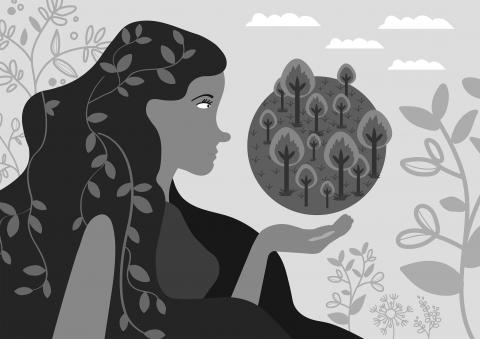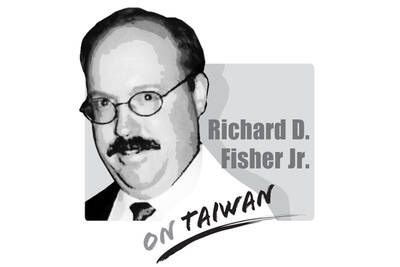Some seek to convey the wonder of endangered animals, while others give tips on how to tackle waste or tell tales of inspirational environmental activists.
All are part of what children’s publishers are calling “the Greta Thunberg effect”: a boom in books aimed at empowering young people to save the planet.
The number of new children’s books looking at the climate crisis, global heating and the natural world has more than doubled over the past 12 months, according to data from Nielsen Book Research shared with the Observer. Sales have also doubled.

Illustration: Lance Liu
Whether it is beautifully illustrated factual books like A Wild Child’s Guide to Endangered Animals, apocalyptic climate catastrophe novels such as Where the River Runs Gold or how-to guides such as Kids Fight Plastic, publishers are targeting a plethora of new fiction and nonfiction titles at young readers inspired by Thunberg, a 16-year-old climate emergency campaigner.
Earth Heroes, which features Thunberg on its cover, is one of them.
A collection of stories by travel journalist Lily Dyu about 20 individual inventors and conservationists around the world, including David Attenborough, Yin Yuzhen (殷玉珍), Stella McCartney and Thunberg, it was snapped up in June by children’s publishers Nosy Crow.
“I absolutely would say there has been a Greta Thunberg effect,” said Rachel Kellehar, head of nonfiction. “She has galvanized the appetite of young people for change, and that has galvanized our appetite, as publishers, for stories that empower our readers to make those changes.”
Kellehar has sent the collection hurtling through the publishing process at breakneck speed so that it will hit bookshelves in early October, just before Thunberg find outs if she will be awarded the Nobel Peace Prize.
“We’re turning this around in four months, which is really unusual in children’s publishing,” she said.
The message of the book is: You’re not alone and you can make a difference, Kellehar said.
“We feel it’s important to get that message out as soon as possible, and that is partly driven by the Greta effect. Whether or not she wins the Nobel Peace Prize, October will be a key moment to reach out and say Greta’s doing this amazing thing, but also lots of other people you have never heard of all around the world are doing amazing things. From young girls in Tunisia who have got plastic bags banned, to an engineer in India who is creating artificial glaciers, this is a book about people who are finding different ways to confront climate change head on, wherever it is affecting them,” she said.
Bloomsbury is to publish a similar collection, Fantastically Great Women who Saved the Planet by Kate Pankhurst, in February.
It features women throughout history who have dedicated their lives to studying, conserving and protecting planet Earth.
Isobel Doster, senior editor in children’s nonfiction, has also noticed a “Thunberg effect” — a “real thirst” for authors who write about environmental role models to whom children can look up and actions they can take to prevent climate change.
“Additionally, there’s been a tonal shift in the natural history books that are coming on to the market,” she said. “It’s not enough just to explore the beauty of the natural world — we have a responsibility to tell readers why it’s important to look after it.”
Plastic is also a hot topic for nonfiction picture books.
Walker Books recently acquired one by MG Leonard called Tale of a Toothbrush, which follows the journey of a single plastic toothbrush, while Hachette Children’s Group brought out A Planet Full of Plastic by Neal Layton earlier this summer.
In fiction, Matt Haig’s illustrated chapter book Evie and the Animals — about a girl who wants to save the planet — won plaudits from critics for its timely storyline and strong appeal for Thunberg fans when it appeared on shelves in June.
Meanwhile, fans of There’s a Rang-Tan in my Bedroom, a moving Greenpeace cartoon that went viral last year, were delighted when it was published last week as a picture book.
Author James Sellick hopes his story — about an orangutan who loses his home and family due to palm oil production and deforestation — will have greater longevity for children in picture-book form, where it can be revisited and given more context from parents.
The book also offers tips about actions children can take, such as writing letters to companies that use palm oil.
“I want not only to educate but to inspire a new wave of eco warriors. Kids are the future. Hopefully if they have been educated about environmental issues from a young age they will go on — and go further — than we are right now,” Sellick said.
Designed in a similar way to inspire the next generation of conservationists, naturalists, biologists, zoologists and nature lovers, A Wild Child’s Guide to Endangered Animals is to be published later this month.
Author and illustrator Millie Marotta said she is hoping the book will tempt young readers to take a lifelong interest in wildlife conservation and show them there are things everyone can do to help, right now.
“We’re losing so many species every year, every month, every day, even. The generation of children who will be reading this book are the ones who are going to be the most impacted, and who will have the biggest impact. They are going to be the people to fix what’s happened and hopefully turn things around,” she said.
‧ Kids Fight Plastic
by Martin Dorey
Written by a long time anti-plastics campaigner and founder of the Beach Clean Network , it shows children what they can do in their home, on days out and at school to reduce the plastic they use.
‧ A Planet Full of Plastic
by Neal Layton
Nonfiction picture book that explains where plastic comes from, why it does not biodegrade and why that is dangerous for animals and the planet.
‧ Where the River Runs Gold
by Sita Brahmachari
An adventure story set in a terrifying caste-divided, dystopian world in which bees have long disappeared and children must labor on farms to pollinate crops.
We are used to hearing that whenever something happens, it means Taiwan is about to fall to China. Chinese President Xi Jinping (習近平) cannot change the color of his socks without China experts claiming it means an invasion is imminent. So, it is no surprise that what happened in Venezuela over the weekend triggered the knee-jerk reaction of saying that Taiwan is next. That is not an opinion on whether US President Donald Trump was right to remove Venezuelan President Nicolas Maduro the way he did or if it is good for Venezuela and the world. There are other, more qualified
China’s recent aggressive military posture around Taiwan simply reflects the truth that China is a millennium behind, as Kobe City Councilor Norihiro Uehata has commented. While democratic countries work for peace, prosperity and progress, authoritarian countries such as Russia and China only care about territorial expansion, superpower status and world dominance, while their people suffer. Two millennia ago, the ancient Chinese philosopher Mencius (孟子) would have advised Chinese President Xi Jinping (習近平) that “people are the most important, state is lesser, and the ruler is the least important.” In fact, the reverse order is causing the great depression in China right now,

This should be the year in which the democracies, especially those in East Asia, lose their fear of the Chinese Communist Party’s (CCP) “one China principle” plus its nuclear “Cognitive Warfare” coercion strategies, all designed to achieve hegemony without fighting. For 2025, stoking regional and global fear was a major goal for the CCP and its People’s Liberation Army (PLA), following on Mao Zedong’s (毛澤東) Little Red Book admonition, “We must be ruthless to our enemies; we must overpower and annihilate them.” But on Dec. 17, 2025, the Trump Administration demonstrated direct defiance of CCP terror with its record US$11.1 billion arms
As technological change sweeps across the world, the focus of education has undergone an inevitable shift toward artificial intelligence (AI) and digital learning. However, the HundrED Global Collection 2026 report has a message that Taiwanese society and education policymakers would do well to reflect on. In the age of AI, the scarcest resource in education is not advanced computing power, but people; and the most urgent global educational crisis is not technological backwardness, but teacher well-being and retention. Covering 52 countries, the report from HundrED, a Finnish nonprofit that reviews and compiles innovative solutions in education from around the world, highlights a